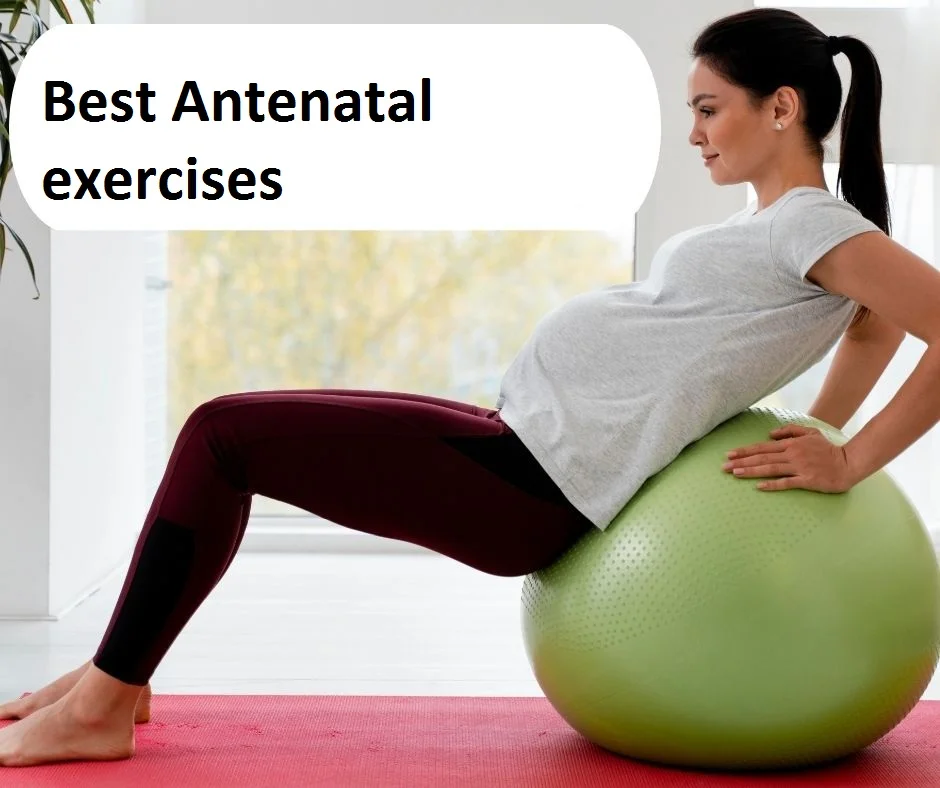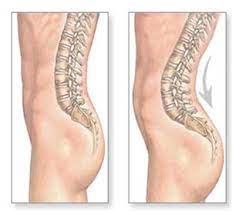Antenatal exercises
Table of Contents
Introduction
Antenatal exercises, also known as prenatal exercises or pregnancy exercises, are physical activities specifically designed for pregnant women to help maintain their overall health and prepare their bodies for labor and delivery.
Antenatal exercises are intended to enhance the physical and mental health of the expectant woman in preparation for labor and to prevent pregnancy-related diseases through a variety of physical measures. It often consists of stretching and low-impact aerobic exercises.
Pregnancy causes some physical changes during the first trimester, such as morning sickness, exhaustion or poor energy, nausea, and increased relaxin hormone release. Exercise helps the mother get over these changes and lifts her spirits and energy levels. Healthy pregnant women should engage in moderate to strenuous aerobic activity for 20 to 30 minutes each day, or at least 150 minutes each week.
Advantages of Antenatal Exercise
- Reduces morning sickness.
- Reduces insomnia, anxiety, and stress.
- other pregnancy-related complaints such as fatigue, leg cramps, edema of the extremities, etc. are lessened.
- Prevents excessive weight gain during pregnancy.
- Improves muscle strength.
- Improves core stability.
- Maintains muscle length and flexibility.
- Improves glycemic control.
- Improves posture.
- Enhances relaxation.
- Prepares for physical demands of labor.
Contraindications
There are absolute contraindications and relative contraindications.
Absolute contraindications
- Ruptured membranes
- Premature labor
- Unexplained PV bleeding
- Placenta previa after 28 weeks
- Pre-eclampsia
- Incompetent cervix
- Intrauterine growth restriction
- Higher-order multiple pregnancies (e.g., twins, triplets, etc.)
- Type 1 or type 2 diabetes, uncontrolled high blood pressure, or thyroid disease
- Other serious cardiovascular, respiratory, or systemic disorders
Relative contraindication
- Recurrent pregnancy loss
- Gestational hypertension
- A history of spontaneous preterm birth
- Mild/moderate cardiovascular or respiratory disease
- Symptomatic Anaemia
- Malnutrition
- Eating disorder
- Twin pregnancy after the 28th week
- Other significant medical conditions
Precautions
Exercises have to be done under close supervision.
After three months of pregnancy, avoid laying supine for more than five minutes.
Holding your breath is known as the Valsalva maneuver.
Avoid making abrupt posture changes.
Always stay hydrated, especially before, during, and after exercises.
Observe the correct warm-up and cool-down procedures.
Be cautious to clear your bladder before exercising.
Avoid workouts that require multiple muscle groups and higher levels of balance.
Goals of Antenatal care
To lower the mortality and morbidity rates among pregnant women and newborns.
To enhance the mental and physical well-being of women and children. to get the woman ready for giving birth, nurse, and take care of her child.
To identify early and properly treat complex conditions that could endanger the mother’s life or the health of the fetus.
Guidelines for Exercises during Pregnancy
Keep up a healthy fluid intake.
To avoid ligament injury, warm up gradually, and use stretches, but don’t overextend.
Take care not to jerk or bounce during exercise.
Watch out for loose throw rugs that might snag and cause harm.
Regularly works out (three times per week).
Exercises requiring supine positioning should be avoided after the first trimester.
1st Trimester Exercises(1 to 12 weeks)
- Deep breathing exercises
- Relaxation exercises
- Postural correction
- Core muscle strengthening
- Pelvic bridging, tilting, rolling
- SLR 30-40 degrees
- Alternate arm and leg raise
- Kegels exercise
- Antenatal education
2nd Trimester Exercises(13 to 26 weeks)
- Deep breathing exercises
- Relaxation techniques
- Stretching calf & hamstring
- Gluteus isometrics
- Quadriceps isometrics
- Side SLR
- Low back stretch
- Walk (Brisk)
- Tailor sitting (6th month
- Labor education
3rd Trimester Exercises (27 to 40 weeks)
- We should decrease the exercises
- Stretching
- Squatting
- Kegels exercises
- Walking for 30-40 mins
- Tailor sitting.
When to seek medical care?
- Excessively shortness of breath
- Chest pain or palpitations
- Dizziness
- Vaginal bleeding
- Abdominal pain
- Reduced fetal movement
Let’s look at the different types of exercises that can be done while pregnant!
Cardiovascular Exercise
The pre-pregnancy fitness level will be evaluated in order to determine the workout’s level of difficulty.
Any aerobic exercise should be selected based on one’s interests, such as walking, swimming, hiking, etc.
Therefore, if walking is a person’s only cardio exercise, it is safe to practice it for 20 to 30 minutes, three to four times per week.
Stretching exercises
Pectoral stretch
This exercise stretches chest muscles mainly pectoralis muscles and reduces the risk of the growth of round shoulders.
Push the ball against a wall or into a corner.
Maintain a straight back while sitting in a comfortable position.
Your hands should remain at your sides or clasped behind your back.
Place your head on the ball and open your chest by letting your elbows open up.
3-5 times are appropriate.
Piriformis stretch
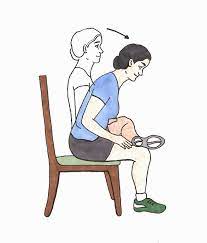
The piriformis muscle is crucial for maintaining pelvic stability and performing ADLs.
Sit on the chair with your pelvis neutral.
Now, with your pelvis still in a neutral position, bend forward from the hips until you feel the stretch.
For 20 to 30 seconds, hold it.
Continue on the opposite side.
Perform 3–5 sets.
Hamstring stretch
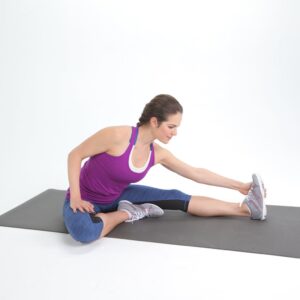
Hamstring tightness can lead to pelvic misalignment and back pain.
This stretch can be done unilaterally or bilaterally and in various positions.
Sit in a long sitting position, bend one knee, and reach as far as you can with your extended leg.
Hold it in place for 20–30 seconds and then switch sides three–five times.
You can also perform a supine hamstring stretch during the first trimester.
Calf stretch
This exercise stretches calf muscles and reduces the risk of deep vein thrombosis during pregnancy.
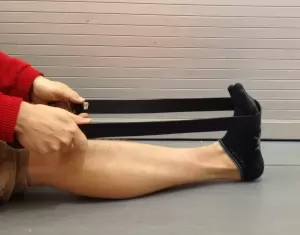
Lay a foam roller, mat, or towel on the ground.
Put your heel on the floor and the ball of your foot on the towel, mat, or roller. maintain a straight leg.
Maintain this posture for 20 to 30 seconds.
Perform 3-5 sets on each side, then repeat on the opposite side.
Hip Opening Stretches To Do During Pregnancy
Butterfly / Tailor Pose

Bring the soles of your shoes together while seated on the ground, allowing your knees to point out to either side.
Draw both heels in as close to the body as is comfortable while holding onto the feet or ankles.
Lean slightly forward and maintain that posture. Put your attention on taking long, deep breaths.
Bring your knees closer to the floor by pressing your thighs down with your hands or elbows for an even deeper stretch. Focus on the stretch and your breathing while holding that position.
The inner thighs, hips, and groin benefit greatly from this great hip-opening stretch. This position not only widens your hips but also relieves lower back pain.
Squats / Garland Pose

Step forward or slightly outward while keeping your feet shoulder-width apart or just wider than hip distance apart.
If it helps, extend the arms out in front for balance as you flex your knees slowly and fluidly.
You pause while supporting your weight with the balls of your heels.
Take a breath, slowly push yourself back up, and then do it again.
Hip Flexor Stretch
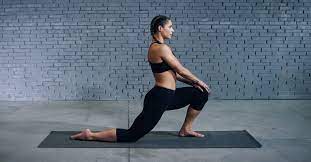
Kneel on your right knee with your left foot in front of you to create a right angle with your leg.
For balance, place your left hand on your left thigh and your right hand on either your right hip or left thigh.
Lean forward while maintaining a straight back, shifting your weight to the forward leg. The right thigh is where you will feel the stretch.
30 seconds of holding, then switch legs and do it again.
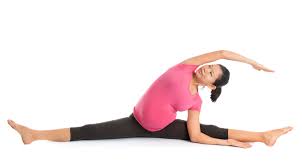
Seated Straddle
Flex your feet and spread your legs wide.
To assist in straightening your spine, press your hamstrings and pelvis firmly into the ground.
If your legs’ backs are sufficiently stretched, hold onto this position or move your hands out in front of you.
Strengthening Exercises
Wall push-ups
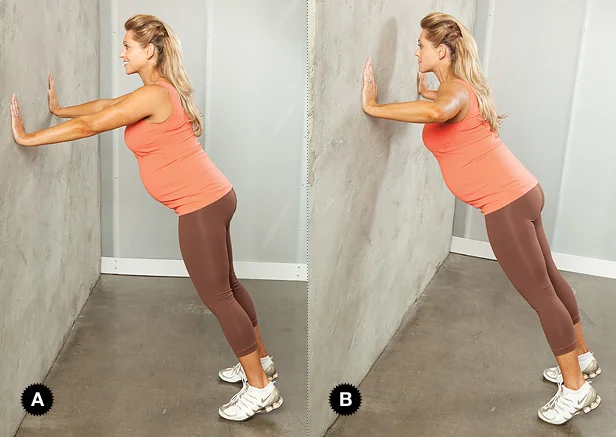
On a wall, position your hands shoulder-width apart.
Put your body in an inclined plank position by stepping your feet back.
Ensure that your body is in proper alignment as you gradually lower your chest.
Breathe out as you return to the starting position of the plank.
5–10 times, then stop.
Single Arm Rows & Seated Row With Resistance Band
One of the best exercises for pregnant women to strengthen their back muscles is single-arm rows. back Strengthening will ultimately assist in restoring your posture, which has been hampered by the expansion of your breasts and belly.
Less strain on the core results from using a bench, and concentrating on just one side at a time can really help the back muscles to stretch and contract.
Find a bench or platform that is long enough to support a knee and a hand on one side of the body to begin this exercise. Get down on all fours on the bench, then extend one leg with the foot firmly planted. Dumbbells can be taken with the same side hand. Row the weight up towards your armpit while raising your elbow above your back. While maintaining the standing elbow in a firm and active stance, extend the back muscles on that side. Maintain chest facing down the entire movement, and do not rotate your body in any way. Repeat as you slowly bring the dumbbell back to its stretched starting position.
Bridging
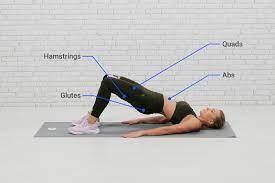
In this exercise, the gluteus maximus and other bigger postural muscles were given more attention.
Hands by your side, knees hip-width apart, and heel under the knee as you lay on your back.
Squeeze your buttocks to lift the pelvis up while maintaining a neutral pelvis.
Hold it for 10 to 20 seconds while breathing normally.
Return slowly to the starting position.
Squats
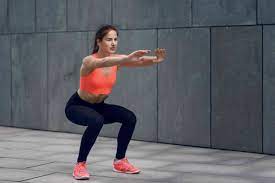
The gluteus maximus is the focus of a great exercise that works all the muscles in the lower extremities.
Place your feet slightly farther apart than hip distance.
Bring the hands forward and clasp them.
Exhale as you squat, making sure the knees don’t extend past the great toes.
As you go up, straighten your legs and press down.
Make sure it is stable.
Lunges
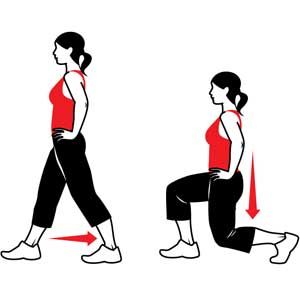
More emphasis was placed on the gluteus, hamstring, and quadriceps during this exercise.
Step forward while keeping your back straight.
In order to load your gluteus and hamstrings rather than your quads, lower yourself now while attempting to keep your front leg vertical.
Straighten your body by pressing your leg down.
Third Trimester Specific Exercises
One should first stand with their feet wide apart and their arms at their sides before starting the duck walk. To prevent unintentional injury to the back and abdominal muscles, it is crucial to maintain tight abdominal muscles while performing the exercise.
After that, one should lower their body from the hips, as if they were about to sit on a chair, making sure that their heels are supporting their weight.
The knees won’t be harmed in this manner. During the duck walk, keeping your balance by clasping your hands in front of your chest can help.
Once you are in the proper position, move forward a few steps at a time while maintaining your squat position, then turn around and slowly walk back to where you started. It is advised that individuals lean forward to maintain balance while performing the duck walk exercise, making sure that the weight stays on the heels.
Placing a resistance band around the ankles at the outset of the exercise is one way to modify the duck walk exercise to make it more challenging. A new exercise technique, also known as the duck walk exercise, calls for the person to squat even lower until they are almost seated on their heels.
The duck walk exercise can be done by women while they are pregnant, especially in the final few months. It will enable the baby’s head to move lower more easily while also strengthening the thighs. With Duck Walk, labor and delivery are made simple and routine.
I. Purposes of antenatal exercise
Antenatal exercise uses joint stretches and muscle strengthening to prevent low back pain and improve physical and mental readiness for delivery.
II. Guidelines for antenatal exercise
Take a deep breath and move slowly and within your capacity.
Work out twice or three times per day, ten times each set of exercises.
When the pregnancy is between 16 and 20 weeks along, prenatal exercise can start.
In light of your physical condition, the physiotherapist might modify the exercise.
III. Types of antenatal exercise
1) Pelvic floor exercise
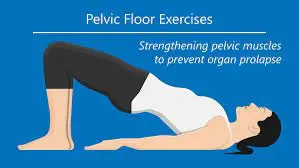
Put your back against the seatback of a chair as you sit down.
Tighten the muscles in your vagina, urethra, and anal regions as if you’re trying to hold back urination or feces. This exercise can also be performed while you are standing.
Exercises for the pelvic floor improve the muscles’ ability to support and control the body. In addition to preventing uterine prolapse, urinary incontinence, and hemorrhoids, it aids in pregnancy preparation.
(2) Back and abdominal exercise

Place your back against the seatback of a chair as you sit down.
Breathe naturally
Your low back should be flat against the seatback by first contracting your abdomen and then pressing your pelvis downward.
You can benefit from this exercise by adjusting your pelvic and low back posture. Your abdominal muscles become stronger, and back pain is prevented.
(3) Ankle exercise

Put your back against the seatback of a chair as you sit down.
Turn the foot upwards and downwards starting at one ankle. Up-and-down motions are counted once for each movement. 10 times in total.
To create an inward or outward circle, rotate the ankle. Circular movements are counted once for each one. Ten times in total.
the other ankle, carry out the same procedures.
Leg cramps are a result of varicose veins and leg swelling, which ankle exercise helps to reduce.
(4) Lower limbs relaxation exercise

The inner thighs and pelvic muscles benefit from increased flexibility and strength from this exercise. It assists you in becoming accustomed to the delivery position and guards against thigh spasms while giving birth.
Place your thighs sideways while seated on a low, stable chair that is against a wall. 5 seconds of holding, then release
(5) Breathing exercise
breathing exercises for labor pain relief. It is advised to exhale before inhaling.
A. Abdominal breathing
appropriate for mild pain
Feel the abdomen grow as you take a deep breath in through your nose. then exhale through your mouth.
B. Lower costal breathing
appropriate for moderate pain
Grasp the lower rib cage with your hands. Feel your chest grow as you take a deep breath in through your nose. Then gently exhale through your mouth.
C. Apical breathing
appropriate for very bad pain
With your mouth slightly open, cross your hands below the clavicles. Inhale through your mouth and nose. Feel the upper lungs shifting a little bit up and down as you exhale lightly as if you’re trying to fan a candle’s flame without blowing it out.
Try to unwind and regulate your breathing while experiencing contractions.
Rest and unwind as much as you can between contractions in the most comfortable position.
Activities of Daily Living
- Becoming active is important during pregnancy However you should avoid activities that are painful and any risk are associated.
- Activities like walking, squatting, lifting, and lunging should be included as much as possible because they will get you ready for Bib Day!
Be sure to drink enough water. - Avoid competing.
- Breathe normally.
- Make sure you won’t exhaust yourself while exercising.
- Take enough breaks to rest.

